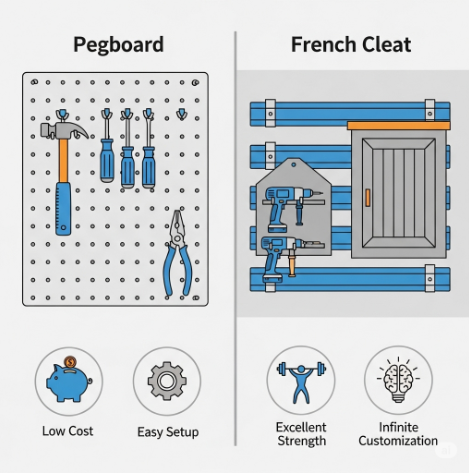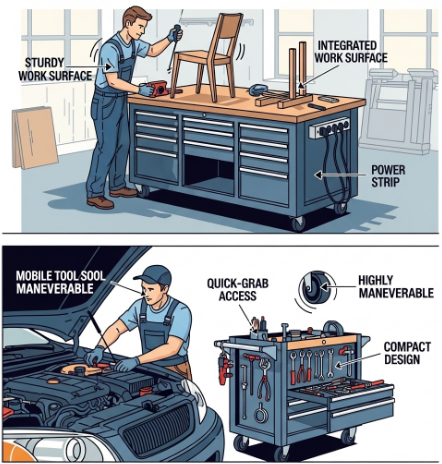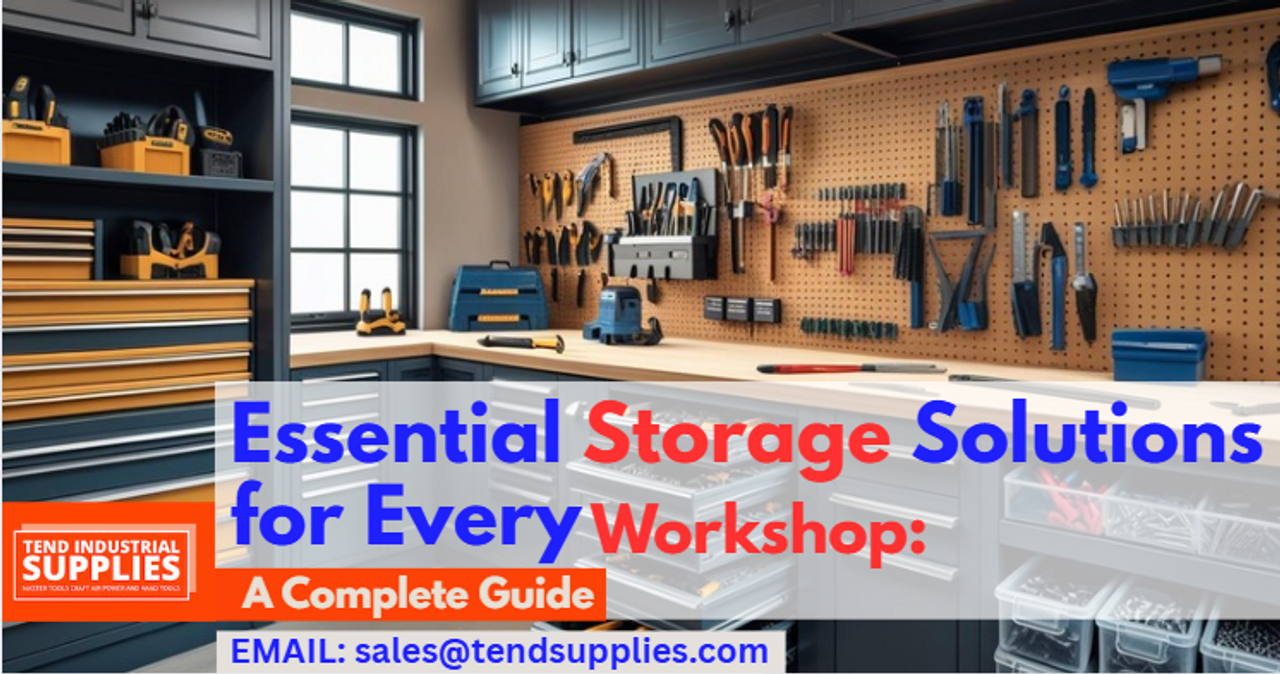Essential Storage Solutions for Every Workshop: A Complete Guide
A workshop is a sanctuary for creativity, but it can quickly descend into chaos. The hunt for a misplaced tool, the frustration of a cluttered workbench, and the challenge of finding workshop storage solutions for small spaces are universal problems for every maker. These common DIY workshop organization mistakes and garage storage fails don't just waste time, they hinder productivity and creativity. That’s why having a well-thought-out storage system isn't a luxury, it's a necessity. An effective storage system is more than just tidy, it's the foundation of an efficient and safe workspace.
This guide is your complete roadmap to transforming your workspace. We'll explore everything from wall mounted power tool storage to the best way to organize screws and nails, helping you conquer the clutter and build the productive workshop you’ve always envisioned. You'll learn how to organize your workshop like a pro, no matter your skill level or space.
Key Takeaways
- Maximize Vertical Space: Use your walls with systems like pegboards for versatility or French cleats for heavy-duty, modular storage to free up valuable floor area.
- Secure High-Value Tools: Invest in lockable tool chests and cabinets to protect your tools from theft and keep them organized and free from dust.
- Embrace Mobility: Incorporate rolling workbenches or tool carts to bring your tools and a workspace directly to your project, which significantly boosts efficiency.
- Conquer Small Part Clutter: A dedicated system for small hardware is essential. Use bin organizers, drawer dividers, and magnetic strips to keep screws, nuts, and bolts sorted and accessible.
- Match Storage to Your Needs: There is no one-size-fits-all solution. The best strategy is to combine different types of storage, wall-mounted, cabinets, mobile carts, and small part organizers, to create a system that fits your specific workflow and tool collection.
Wall-Mounted Storage: Maximize Your Vertical Space
Utilizing your walls is the most effective way to free up valuable floor space and keep frequently used tools within easy reach.
Pegboards: The Classic, Versatile Choice
Pegboard is a system of perforated hardboard sheets that accept a wide variety of hooks, hangers, and bins. It's affordable, widely available, and incredibly versatile.
- Pros:
- Highly customizable with endless layout possibilities.
- Affordable and easy to find at any home improvement store.
- Excellent for visualizing your entire tool collection at a glance.
- Cons:
- Standard pegboard hooks can sometimes fall out.
- May not support extremely heavy items unless properly reinforced.
- Best For: Hand tools, smaller power tools, and creating dedicated stations for specific tasks.
French Cleats: The Strong and Modular System
A French cleat system consists of two interlocking 45-degree angled boards. One is fixed to the wall, and the other is attached to a cabinet, shelf, or custom tool holder. This creates an incredibly strong and fully modular system.
- Pros:
- Extremely strong and can hold significant weight, including full cabinets.
- Infinitely customizable; you can build holders for any tool imaginable.
- Easy to rearrange and move heavy items without fasteners.
- Cons:
- Requires more initial setup and basic woodworking skills (DIY approach).
- Can be more expensive than a pegboard if purchasing a pre-made system.
Comparison: Pegboard vs. French Cleat
|
Feature |
Pegboard |
French Cleat |
|
Strength |
Good |
Excellent |
|
Cost |
Low |
Moderate to High |
|
Customization |
High (with standard hooks) |
Infinite (with custom holders) |
|
Ease of Setup |
Easy |
Moderate |
|
Best For |
Hand tools, quick setup |
Heavy items, custom cabinets |

An Infographic Showing Comparison of a Pegboard and a French Cleat System
Tool Chests and Cabinets: Secure and Organized Storage
For valuable tools, large collections, and items that need protection from dust and debris, chests and cabinets are indispensable.
Rolling Tool Chests
These are the workhorses of mechanical and automotive shops. A typical setup includes a top chest that sits on a larger bottom rolling cabinet, offering a multitude of drawers in various depths.
- Pros:
- Excellent organization with separated drawers.
- Secure and lockable to protect your investment.
- Mobile, allowing you to bring your entire toolset to the project.
- Cons:
- Can be a significant investment.
- Takes up a considerable amount of floor space.
- Best For: Mechanics, fabricators, and anyone with a large collection of sockets, wrenches, and specialized hand tools.
Stationary Cabinets
Stationary cabinets, whether freestanding or wall-mounted, provide bulk storage for larger items. They are perfect for storing power tool cases, supplies, and less frequently used equipment.
- Pros:
- Keeps items protected from dust and workshop debris.
- Great for bulk storage of chemicals, rags, and larger tools.
- Wall-mounted options save floor space.
- Cons:
- Not mobile, so tools must be carried to the work area.
- Can be difficult to organize internally without additional bins or dividers.
- Best For: Storing power tool kits, finishing supplies, and workshop consumables.
Mobile Storage: Bring Your Tools to the Job
Mobile storage solutions bridge the gap between your main tool chest and your immediate work area, boosting efficiency.
Rolling Workbenches
A rolling workbench combines a sturdy work surface with built-in storage drawers and shelves. It's a workshop hub that can move wherever you need it.
- Pros:
- Provides a work surface and storage in one unit.
- Keeps essential project tools close at hand.
- Often includes features like a built-in vise or power strip.
- Cons:
- Less storage capacity than a dedicated tool chest.
- The work surface can become cluttered.
- Best For: Assembly projects, woodworking, and electronics work where a mobile, flat surface is key.
Tool Carts
A tool cart is a more compact, open-shelf version of a rolling chest. It's designed for quickly grabbing tools for a specific job.
- Pros:
- Lightweight and highly maneuverable.
- Open design makes it easy to see and grab tools quickly.
- More affordable than a full tool chest or rolling workbench.
- Cons:
- Offers no security and limited protection from dust.
- Can become disorganized easily.
- Best For: Quick repairs, automotive work, and moving a curated set of tools around a large space.

A Dynamic Infographic Showing the Two Main Mobile Solutions in their Ideal Environments
Small Part and Hardware Storage: Conquer the Clutter
Screws, nuts, bolts, and other small hardware can quickly create chaos. A dedicated system is not a luxury—it's a necessity.
Bin Organizers
These systems range from stackable plastic bins to wall-mounted racks. They are perfect for sorting and storing hardware and small components. Look for clear or labeled bins for easy identification.
Drawer Dividers
Don't let your tool chest drawers become a junk drawer. Use modular plastic or metal dividers to create specific compartments for sockets, screwdriver bits, and other small items.
Magnetic Strips
A simple magnetic bar mounted on the wall is an incredibly efficient way to hold drill bits, wrenches, and any other steel tool you need to grab frequently.
By combining these essential storage solutions, you can create a workshop that is tailored to your workflow, making every project more efficient, enjoyable, and safe.
Frequently Asked Questions (FAQs)
- What is the best storage system if I'm on a tight budget?
The most budget-friendly options mentioned are pegboards, which are inexpensive and widely available, and DIY solutions like building your own French cleat system or using simple magnetic strips for metal tools.
- I have very heavy tools and cabinets to hang. What wall storage should I use?
For heavy items, the French cleat system is the best choice. It is noted for its excellent strength and ability to hold significant weight, including full cabinets, far surpassing the capacity of standard pegboard.
- What's the real difference between a pegboard and a French cleat system?
The main differences are strength, cost, and customization. Pegboard is cheaper and easier to set up for hanging standard hand tools. A French cleat system is much stronger, infinitely customizable for any tool (especially with custom-built holders), but requires more initial work and cost.
- How can I keep my expensive tool collection secure?
Rolling tool chests and stationary cabinets are the best options for security. They are typically made of steel and feature locking mechanisms to protect your investment from theft and keep them organized.
- I need to move my tools around my workshop frequently. What's better, a rolling workbench or a tool cart?
It depends on your needs. A rolling workbench is ideal if you need a mobile work surface combined with storage. A tool cart is a more lightweight, maneuverable, and affordable option designed for quickly grabbing a specific set of tools and moving them to a job.
- My tool chest drawers are a complete mess. How can I fix this? The guide recommends using modular drawer dividers. These allow you to create specific, organized compartments for small items like sockets, wrenches, and screwdriver bits, preventing them from becoming a "junk drawer."
- How can I organize all my loose screws, nuts, and bolts?
For small hardware, the most effective solutions are dedicated bin organizers (either stackable or wall-mounted) and drawer dividers. Using clear or well-labeled bins is crucial for quickly identifying what you need.
Related Articles:
- The Ultimate Guide to Workshop Storage: Ideas, Layouts & Organization Tips
- Workshop Tool Storage Solutions: Organize and Store Your Tools Efficiently
- How to Create a Tool Storage System for Your Workshop
- How to Organize Your Workshop Efficiently
- 5 Common Workshop Storage Mistakes and How to Avoid Them
Conclusion
Knowing how to organize a cluttered workshop is the first step toward transforming it into a model of efficiency. This change doesn’t rely on a single magic product, but rather a strategic blend of the solutions we've explored. The ultimate goal is to create customizable tool organization systems where every tool has a designated home and every component is within easy reach. By implementing the best wall-mounted storage for small workshops, securing valuable assets in secure tool storage chests and cabinets, and creating a mobile tool cart setup for easy access, you build a solid foundation for better work.
The journey to an organized workshop is not about achieving perfection overnight. It's about making incremental improvements and creating an efficient workshop workflow that reduces friction. Start today with a step-by-step workshop organization plan: assess your most cluttered area and choose one solution to implement, such as a DIY workshop storage solution for small spaces. Your investment will pay dividends in every future project.
Whether you're a weekend DIYer or a full-time professional, these essential storage solutions for small and large workshops help reduce downtime, protect your tools, and enhance your workflow. Start small, optimize what you have, and scale as needed, because an organized workshop is the foundation of every successful project, creating a more enjoyable space where you can truly focus on your craft.
Call to Action
Ready to Build Your Perfect Workshop? Stop searching and start organizing. Explore our complete collection of high-quality tool chests, wall-mounted racks, and mobile storage solutions at Tendsupplies.com. For bulk orders or personalized recommendations, contact our expert team directly at sales@tendsupplies.com and get your workshop equipped today!





